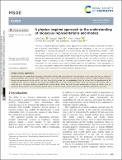| dc.contributor.author | Dicks, Luke | |
| dc.contributor.author | Graff, David E | |
| dc.contributor.author | Jordan, Kirk E | |
| dc.contributor.author | Coley, Connor W | |
| dc.contributor.author | Pyzer-Knapp, Edward O | |
| dc.date.accessioned | 2025-02-05T20:26:39Z | |
| dc.date.available | 2025-02-05T20:26:39Z | |
| dc.date.issued | 2024 | |
| dc.identifier.uri | https://hdl.handle.net/1721.1/158177 | |
| dc.description.abstract | The story of machine learning in general, and its application to molecular design in particular, has been a tale of evolving representations of data. Understanding the implications of the use of a particular representation – including the existence of so-called ‘activity cliffs’ for cheminformatics models – is the key to their successful use for molecular discovery. In this work we present a physics-inspired methodology which exploits analogies between model response surfaces and energy landscapes to richly describe the relationship between the representation and the model. From these similarities, a metric emerges which is analogous to the commonly used frustration metric from the chemical physics community. This new property shows state-of-the-art prediction of model error, whilst belonging to a novel class of roughness measure that extends beyond the known data allowing the trivial identification of activity cliffs even in the absence of related training or evaluation data. | en_US |
| dc.language.iso | en | |
| dc.publisher | Royal Society of Chemistry | en_US |
| dc.relation.isversionof | 10.1039/d3me00189j | en_US |
| dc.rights | Creative Commons Attribution | en_US |
| dc.rights.uri | https://creativecommons.org/licenses/by/4.0/ | en_US |
| dc.source | Royal Society of Chemistry | en_US |
| dc.title | A physics-inspired approach to the understanding of molecular representations and models | en_US |
| dc.type | Article | en_US |
| dc.identifier.citation | Dicks, Luke, Graff, David E, Jordan, Kirk E, Coley, Connor W and Pyzer-Knapp, Edward O. 2024. "A physics-inspired approach to the understanding of molecular representations and models." Molecular Systems Design & Engineering, 9 (5). | |
| dc.contributor.department | Massachusetts Institute of Technology. Department of Chemical Engineering | en_US |
| dc.contributor.department | Massachusetts Institute of Technology. Department of Electrical Engineering and Computer Science | en_US |
| dc.relation.journal | Molecular Systems Design & Engineering | en_US |
| dc.eprint.version | Final published version | en_US |
| dc.type.uri | http://purl.org/eprint/type/JournalArticle | en_US |
| eprint.status | http://purl.org/eprint/status/PeerReviewed | en_US |
| dc.date.updated | 2025-02-05T20:20:50Z | |
| dspace.orderedauthors | Dicks, L; Graff, DE; Jordan, KE; Coley, CW; Pyzer-Knapp, EO | en_US |
| dspace.date.submission | 2025-02-05T20:20:51Z | |
| mit.journal.volume | 9 | en_US |
| mit.journal.issue | 5 | en_US |
| mit.license | PUBLISHER_CC | |
| mit.metadata.status | Authority Work and Publication Information Needed | en_US |
